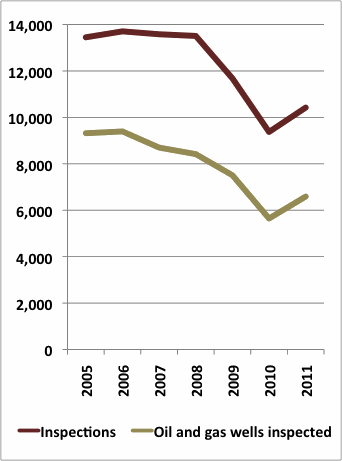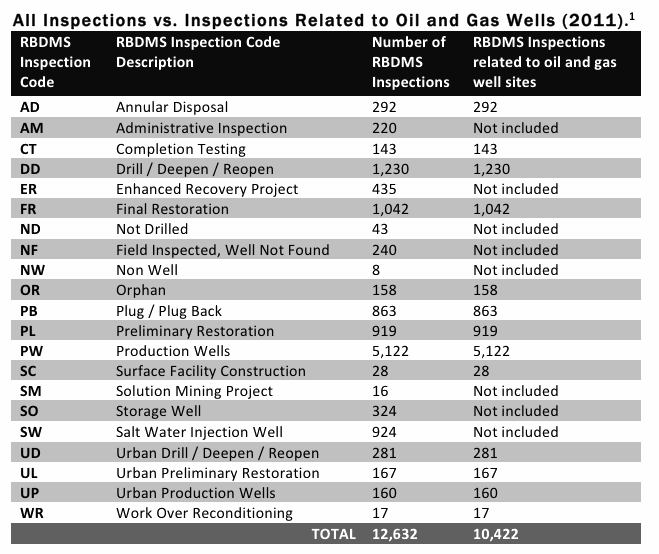Ohio Oil & Gas Enforcement - Inspections
Inspections down from 2005
Ohio oil and gas inspections

Click chart for larger version
The number of inspections of oil and gas wells in Ohio is currently below what it was in the mid-2000s. This is true even though the number of active wells increased from 62,675 in 2005 to more than 64,000 in 2011.[1]
As seen in the chart, in 2005 oil and gas inspectors conducted approximately 13,500 inspections and visited more than 9,000 active wells in the state. By 2011, DOGRM had reduced the number of oil and gas inspections by 3,000 per year, and as a result, inspected just 6,500 of the state’s active wells.[2]
Currently, a large percentage of Ohio’s active wells are stripper wells (i.e., produce fewer than 10 barrels or oil or less than 60 thousand cubic feet of gas per day). Even though these are low-producing wells, however, it is still imperative that they be inspected on a regular basis as corrosion, and consequently leaks of produced water and hydrocarbons can be a problem for stripper wells.[3] According to a 2003 report prepared for the Department of Energy, “Due to the limited income associated with stripper oil and gas wells, many operators often cannot afford to implement the level of corrosion control methods utilized by major . . companies.”[4]
Relative to other states that we reviewed, Ohio ranks low in terms of how many inspections it conducts per year. As seen from the table, Ohio has more active oil and gas wells than Colorado and New Mexico, but in 2010 Ohio inspectors conducted half the number of inspections of their New Mexico counterparts, and only 65 percent of what inspectors in Colorado performed.
Estimated number of active wells that were not inspected in 2010

Click chart for larger, footnoted version
Perhaps even mores striking, data in the table reveal that in 2010 Ohio failed to perform inspections at 91 percent of the state’s active oil and gas wells. More than 58,000 oil and gas wells had no regulatory oversight that year. The situation did not improve in 2011. That year, approximately 90% of wells did not get inspected.[5]
|
Box 1: Notes on Ohio inspections data. |
|
What data are publicly available? Ohio’s Division of Oil and Gas Resources Management Risk Based Data Management System (RBDMS) contains useful information on inspections, violations and other oil and gas related data. It is important, however, to know that the data include not just oil and gas production wells, but also gas storage wells, saltwater disposal wells, solution mining wells and others. Depending on which types of wells are included when data are analyzed, different statistics will be generated. For example, Earthworks’ search of RBDMS inspections led to different numbers than what were provided to Earthworks by the Ohio Division of Minerals Resource Management (DOGRM). Earthworks’ initial search of RBDMS found 12,632 inspections of all types of wells in 2011. When we removed inspections that we deemed were not related specifically to oil and gas production wells and surface facilities (i.e., we excluded administrative inspections, inspections of brine haulers, enhanced recovery wells, solution mining wells, gas storage wells and saltwater injection wells), the RBDMS data showed that 10,422 inspections took place in 2011.[12] Apparently, DOGRM used a much narrower definition of an oil and gas well inspection than Earthworks, because DOGRM told Earthworks that there were 9,194 inspections of oil and gas wells in 2011.[13] Given the large opportunity for misunderstanding or misinformation, it would be wise for DOGRM (and anyone else who uses RBDMS) to always be very clear about what data were and were not used to generate oil and gas statistics. Alternatively, DOGRM could establish a separate on-line, searchable database that includes inspection data and other enforcement-related information for oil and gas wells. |
More inspectors needed
In 2010, Ohio passed Senate Bill 165, which made changes to and updated the Oil and Gas Law. In the bill’s fiscal note, it was estimated that 33 new staff would be added to the oil and gas program to deal with regulatory responsibilities added by the bill. These staff increases would be “supported in large part by the new and increased fees proposed in the bill.” The bill did not specify how many of the new staff would be oil and gas inspectors, nor how soon the new employees would be hired.
The DOGRM web site shows that there are now 27 inspectors in Ohio,[6] up from 21 in 2010.[7] While the hiring of additional inspectors led to an increase in the number of inspections, it is still not enough to ensure adequate oversight of oil and gas operations in Ohio. As mentioned above, only 90% of Ohio's active wells were inspected in 2011.
Also, when compared to states like Pennsylvania the workload of each Ohio inspector is immense. In 2011, each Pennsylvania oil and gas inspector was responsible for 885 active wells, on average.[8] Meanwhile, with 64,481 active wells and just 27 inspectors, each Ohio inspector was responsible for an average of 2,388 active wells in 2011—more than twice the number of their Pennsylvania counterparts. It is virtually impossible for one inspector to visit, let alone carefully inspect, 2,388 well sites a year.
According to other states, all new wells should be inspected at least three times (e.g., twice during the drilling/completion process, and once after drilling is completed), and each active wells should be inspected at least once a year.[9] This means that OCD should have performed at least 65,000 inspections in 2011.[10] They conducted approximately 10,000.[11]
Clearly, DOGRM lacks the capacity to provide adequate oversight of existing wells, and is poorly positioned to provide adequate oversight for the planned addition of thousands of new shale oil and gas wells that may be developed in both the Marcellus and the Utica Shale formations.
For more information:
- Earthworks: Enforcement Report - DOGRM: Public should not have confidence that oil and gas development is occurring responsibly in the state of Ohio. Report
- Earthworks: Ohio Oil & Gas Enforcement. Web page
- Earthworks: Ohio Oil & Gas Enforcement - Inspections. Web page
- Earthworks: Ohio Oil & Gas Enforcement - Violations. Web page
- Earthworks: Ohio Oil & Gas Enforcement - Enforcement Actions. Web page
Endnotes
1 Active well data found in: Ohio Division of Mineral Resources Management. Summary of Ohio Oil and Gas Activities. 2008 to 2011 reports.
2 All data come from RBDMS "tblInspections". RBDMS data updated and accessed March 7, 2012. To find oil and gas inspections for different years: Filtered "tblInspection" by dates: between 1/1/2011 and 12/31/2011 (similarly for other years). Then filtered to include only oil and gas well inspections – i.e., codes AD, CT, DD, FR, OR, PB, PL, PW, SC, UD, UL, UP and WR. See Endnote 1 for more information.
3 “Corrosion affects every stripper well to some degree and if left unchecked results in the repair or replacement of casing, rods, tubing, separators, production tanks, and pipelines. Additional effects include lost or deferred production . . . environmental damage and associated penalties, and decreased safety.” (Source: James, J., Huck, G. and Knobloch, T. Dec. 2003. A Study to Evaluate the Effect of Cost of Corrosion on Stripper Well Operations. Final Technical Progress Report to the U.S. Department of Energy. p. 6.
4 id. p. 1.
5 See Table: Ohio Inspection data.
6 This number is based on current listing of oil and gas field inspectors on the DOGRM web site. It does not include supervisors, but does include back-up inspectors. (Information accessed March 7, 2012)
7 State Review of Oil and Natural Gas Environmental Regulations (STRONGER), Inc. January 2011. Ohio Hydraulic Fracturing State Review. p. 6.
8 In 2011 there were 77,898 active wells in Pennsylvania, and approximately 88 inspectors. So each inspector was responsible for 77,898/88 = 885 active wells. Pennsylvania inspector and active well data available on Earthworks’ Pennsylvania Enforcement web page. Or see Table: State-by-state comparison of inspection staff and activity (2011). View table footnotes here.
9 Pennsylvania: Pennsylvania Code. Title 25 §78.901-906. Inspection Policy Regarding Oil and Gas Wells. North Dakota: Western Organization of Resource Councils. 2005. Law and Order in the Gas Fields. p. 7. New York: Division of Mineral Resources. 2009 Oil, Gas and Mineral Resources Annual Report. p. 20.
10 According DOGRM's 2011 Ohio Oil and Gas Summary, there were 460 oil and gas wells drilled in Ohio in 2011. So at least 1,380 inspections should have occurred at these well sites (460 x at least three inspections per new well). In 2011 there were approximately 64,481 active wells (so, at approximate 64,000 of these were not new wells). Each existing active well should have been inspected at least once. Therefore, 1,380 new well inspections + 64,000 active well inspections = approximately 65,380 inspections.
11 Earthworks found 10,422 inspections in RBDMS database, and DOGRM told earthworks that 9,194 inspections were conducted in 2011. See Box 1.
12 View the data and find out how we derived our numbers.
Ohio oil and gas inspections by type (2011)

Click chart for larger, footnoted version
13 Email request for data made Sept. 16, 2011, data received Oct. 4, 2011 from Beth Wilson, Public Information Officer with Ohio Division of Oil and Gas Resources Management. Updated information received March 1, 2012.
Tagged with: regulations, ohio division of oil and gas resources management, ohio, inspections, fracking, enforcement, drilling
Follow Earthworks